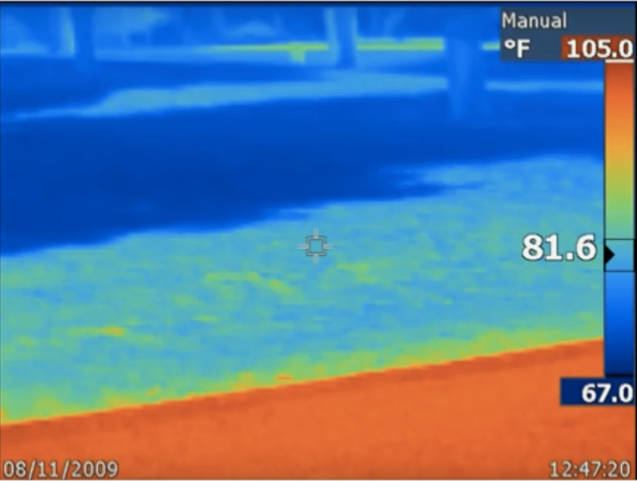To whom it may concern:
I’m writing to add my voice in support of preservation of the public shade tree at 142 Forest Street, which by Mass. State law is receiving a public hearing today.
I’ve heard from multiple concerned Watertown residents about the risk to this tree. All reports indicate that this is a vigorous, healthy pin oak which is providing significant benefits to the neighborhood and if preserved and protected should have decades of healthy service ahead.
In sweltering hot weather, large-canopy urban trees like this oak play a critical role in cooling city neighborhoods. See for example the attached infrared photo showing the temperature on an 81.6F degree day of tree-shaded lawn, nearby un-tree-shaded lawn, and nearby unshaded pavement. As this IR photo illustrates, the temperature difference between tree-shaded and hard unshaded surfaces can be tens of degrees.

This has major implications for public health and for energy use. Unshaded pavement on a hot summer day absorbs enough heat to severely burn a dog’s paws. The heat radiating from this hot pavement bakes pedestrians, bicyclists, and cars. It bakes nearby plantings, including tender young trees. Along with direct sunlight this reflected heat bakes nearby buildings, increasing air conditioning costs and the burden on the power grid.
The critical protective role urban tree canopy plays doesn’t stop when the sun goes down. Unshaded hard surfaces store up infrared energy in the summer like the walls of an oven, and like the walls of an oven they radiate that heat at night, keeping urban neighborhoods hot. Tree canopy blocks this heat storage and evaporatively cools the air, substantially reducing ambient nighttime temperatures.
Big healthy shade trees have many other benefits too. To highlight just a couple:
— Experiencing healthy tree canopy, and even just seeing it daily, provides measurable psychological and physiological benefits. Multiple studies have shown this makes us healthier and makes urban neighborhoods friendlier and safer.
— Preservation of healthy neighborhood tree canopy is increasingly important with increasing frequency and intensity of heavy rainfalls. Big healthy shade trees have big root systems which can absorb and filter thousands of gallons of storm water annually, and their big protective canopies temper the force of deluges. This helps prevent flooding of roads and cellars.
Planting new trees is very important too. Every well-selected, well-sited, new urban shade tree is a blessing for the whole neighborhood. But it takes many years for a new tree to provide the magnitude of ecoogical services and community benefits that an existing mature shade tree provides. And in the harsh urban environment, those intermediate years are fraught with risk for a new tree.
Speaking as President of Trees for Watertown and as a fellow citizen, I urge Watertown residents and property developers to make every effort to prioritize the preservation of existing healthy shade trees on public and on private land. Watertown needs this hard-working green infrastructure now, and we will need it even more in future.
Sincerely,
Libby Shaw
President, Trees for Watertown
Why would this tree be cut down? Makes no sense. We should be increasing our inventory of shade trees, not reducing it. The benefits of these trees are many.
Can someone post a picture of the pin oak that this conversation is about? It would be a shame to cut down a viable healthy shade tree. It would also be a shame if it’s already half dead and a branch fell on a resident walking under it. Clearly, healthy public trees should not be cut down. Let’s see the tree.
I support preserving this tree. Mature trees are essential to create fresh oxygen and cooling shade for the inhabitants. Who wants it removed and why??
Excellent explanation, Libby. Thank you. I hope you managed to save OUR tree.
Barbara
save as many trees as possible. Crucial to quality of life. Watertown has allowed too many building to go up and too many trees to come down. We’d be better off with fewer buildings and more trees.
You can read more about this tree on our map OpenTreeMap. This includes a google street view of the tree.
Thanks, David!
Here’s a link to Trees for Watertown’s tree inventory.
https://www.opentreemap.org/watertownma
Enter 142 Forest in the location field to learn more about this beautiful pin oak.
TFW’s Teens for Trees and several TFW volunteers collected the data for this inventory over the last couple summers. This has been a valuable resource for Town forestry planning. It’s also a helpful resource for citizens who’d like to identify a specific tree.
Trees are planted, are taken down, and their size and condition may change with time, so to stay useful a tree inventory needs to be updated regularly. COVID kept us from running the Teens for Trees program this summer, but we hope to return to the program next year. Meanwhile: if you notice a tree or tree site in the database that needs updating, please let us know! treesforwatertownma@gmail.com
The Open Tree Map thing is kind’a neat, the only problem is that the most recent Google Streets snapshot is from 2013… 7 years ago. What does the tree currently look like?
Is it all the wires that are causing the problem?
https://www.google.com/maps/@42.3743993,-71.1874816,3a,90y,10.05h,114.44t/data=!3m7!1e1!3m5!1sJdeHp2TqcDzy1hDLe6BBGw!2e0!5s20130901T000000!7i13312!8i6656
Hi, Alan:
Removal was requested by the developer of 142 Forest who wants to put in a new driveway.
Easiest way to see what this pin oak looks like today is to pay it a visit.
I hope this tree is not removed provided it is healthy & safe! Trees provide so many benefits & take decades to grow to full size. Due to developments we are loosing too many trees! They are a great investment for our neighborhoods, for our residents & pets. Libby- Thank you for your very helpful & detailed explanation here!